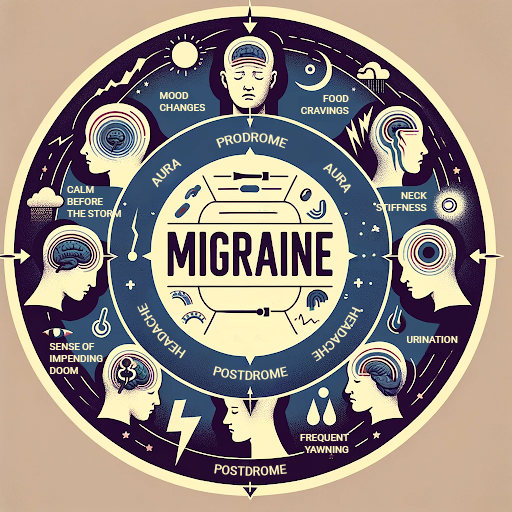Migraines are a complex medical condition that affects millions worldwide. Unlike common headaches, migraines come with a variety of symptoms and can significantly impact daily life. Understanding the distinct phases of a migraine can help sufferers manage their symptoms more effectively. This post explores the four key phases of a migraine attack and provides insights into the symptoms and management strategies for each phase.
1. Prodrome Phase
The prodrome phase, often referred to as the pre-headache or premonitory phase, occurs hours or days before the migraine attack. Approximately 60% of people with migraines experience prodrome symptoms, which serve as early warning signs.
Common symptoms include:
- Mood changes (depression)
- Food cravings
- Neck stiffness
- Increased thirst and urination
- Frequent yawning
- Sense of impending doom
- Calm before the storm
Management Tips:
Recognizing these early signs provides a chance to prevent a full-blown migraine attack through lifestyle adjustments or medication.
2. Aura Phase
Not everyone will experience the aura phase, but for those who do, it’s a distinct part of the migraine process. Auras affect about 20-30% of migraine sufferers and involve neurological symptoms that typically precede the headache phase.
Common symptoms include:
- Visual disturbances (flashes of light, blind spots, zigzag patterns)
- Sensory changes (tingling or numbness on one side of the body)
- Speech disturbances
- Weakness or heaviness in the limbs
Management Tips:
Auras usually last between 5 minutes to an hour. If you experience auras, finding a quiet, dark place to rest can help mitigate the discomfort. Medications may also be prescribed to manage aura symptoms.
3. Headache Phase
The headache phase is what most people associate with migraines. This phase can last from a few hours to several days.
Common symptoms include:
- Pain on one side or both sides of your head
- Pulsating or throbbing pain
- Sensitivity to light, sounds, and sometimes smells and touch
- Nausea and vomiting
Management Tips:
Pain management is crucial in this phase. Over-the-counter or prescription medications can alleviate pain, while rest, hydration, and avoiding triggers are also beneficial. Some find relief in dark, quiet rooms.
4. Postdrome Phase
Following the headache, many experience the postdrome phase, often dubbed the “migraine hangover.” Symptoms can linger for a day after the headache subsides.
Common symptoms include:
- Fatigue
- Mood changes
- Weakness
- Sensitivity to light and sound
Management Tips:
Recovery is key during the postdrome phase. Gentle activities, plenty of fluids, and rest can help the body recover. It’s also important to reflect on the migraine attack to identify any potential triggers or effective relief strategies for future episodes.
Migraines are more than just headaches; they’re a multi-phase condition that requires understanding and management. Recognizing the signs and symptoms of each phase can empower sufferers to take proactive steps to manage their condition. At The Health League, we’re committed to helping you navigate through each phase of a migraine, offering personalized treatment plans and support to improve your quality of life. If you’re struggling with migraines, reach out to us for comprehensive care tailored to your unique needs.
